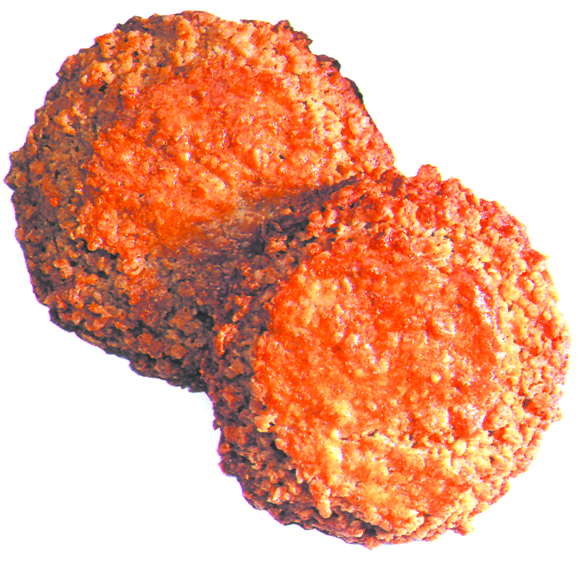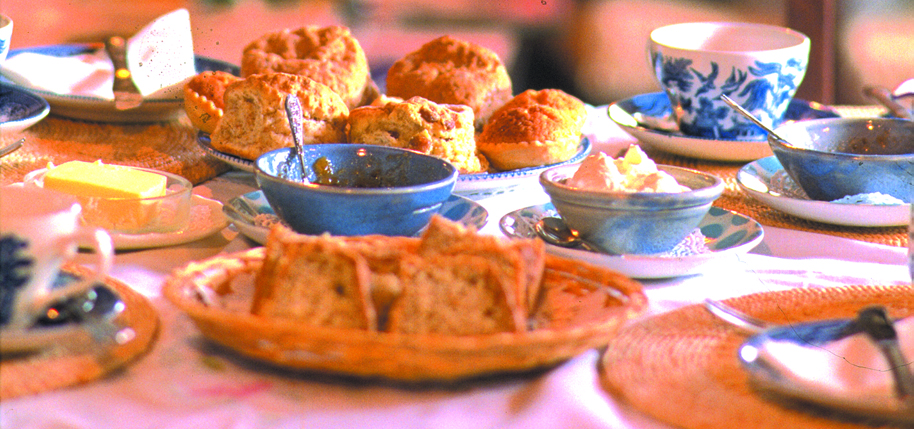Call me crazy, but oatmeal cookies have never had a spot on my favorite foods list. They’re too sweet. I prefer my oats prepared in such a way that I can really taste the full nutty flavor. I even enjoy eating them by the dusty flaky mouth-gumming uncooked handful. That taste quirk may be a result of genetic memory. My father’s father, his father, and many of the other male branches on my Irish family tree were horsemen — jockeys, trainers, groomers, exercise lads, and Hansom cab drivers. It wouldn’t surprise me at all if when they were hungry they simply dipped their hands into an oat-bag and munched a mouthful of rations belonging to one of their charges.
Every stable hand knows that horses love oats, but the grain is a favorite of humans as well. In fact, oats were one of the original domesticated grains in human history. Thousands of years ago, when the first Celts migrated from the European mainland to what is now Ireland they carried oat seeds with them, and the grain served as a staple of the Irish diet from prehistoric times until the 17th century when it was replaced by the potato. Even so, during the devastating Famine years when the potato crops failed, people reverted to oats, when available, as their primary source of nutrition.
Not only were oats nutritious, they were also extremely easy to grow. Unlike corn, which must be planted in neat rows and carefully nurtured until harvest, oats can simply be broadcast by the handful into the air to root and mature where they fall. Oats found Ireland’s rich limestone soil, gentle rain, and cool climate especially to their liking. The plants flourished like weeds and with little to no overseeing could always be counted on to deliver a bumper crop at harvest time. Barley, wheat and rye had to be separated from their husks by threshing before being dried in a kiln, but the whole oat sheaf could be burned in its entirety and the ashes sifted to retrieve the toasted grain. This “burning in the sheaf” combined the labor-intensive processes of threshing, winnowing and drying into one simple operation, but so much straw needed to thatch roofs was destroyed in the process that eventually many regions passed laws to abolish the practice.
It was not the first time that oats found their way into the Irish legal code. In the 16th and 17th centuries ground oatmeal was considered an acceptable element of the “food rents” that were paid to landlords. In the 9th century Rule of Tallaght which regulated food for the Culdee monks, the monastery’s abbot Maolruain wrote that if a festival happened to fall on certain days the monks were to be given meanadhach, a watery oatmeal gruel. Two centuries earlier the Senchus Mor, a section of the Brehon Laws addressing the care of children who had been fostered out, dictated the kinds of porridge they should be fed according to a rigid class structure. Wheat, which was in scarce supply and therefore valuable, was reserved for children of the aristocracy. Landowners’ offspring were fed from the greater stores of barley. Poor youngsters received the most common and least socially valued grain — oatmeal, commonly known as “stirabout” because it must be stirred constantly while cooking.
Although it seems that the Brehon Laws only stipulated what fosterlings should eat at breakfast, that is not the case. Porridge, especially oatmeal porridge, came to the table in many guises throughout the day. Mixed with butter and salt, it was served as an accompaniment to meat. Combined with herbs and/or bits of bacon, it could stand alone as a meal in itself. Stirred into flour and baked, it made a healthy hearty loaf of bread. Adding honey and spices turned ordinary stirabout into a dessert. In grand manor houses delicious fruit crumbles were created by baking a dish of sliced apples or rhubarb with a topping of oats, butter, sugar and chopped nuts, and adding oats, candied fruit and raisins to plain flour dough transformed ordinary scones into wonderful little sweet cakes.
When the husks that remained after oatmeal was ground at the mill were soaked in water, the result was a milky-looking drink called sowans. If the husks were soaked for weeks, the liquid fermented and was known as Bull’s Milk. Once the solids were strained out, Bull’s Milk could be drunk in lieu of cow’s milk, added to tea, or substituted for buttermilk in baking recipes. Since all the nutrients had been leached from the husks during the soaking process, Bull’s Milk was extremely nutritious. It was the only food allowed on Lenten fast days, and it was a refreshing thirst quencher for turf cutters and field workers during planting and harvest seasons. Sowans could also be boiled over a hot fire and stirred until it thickened to the consistency of jelly. Adding sugar and honey transformed the humble gruel into a sweet dessert known as flummery.

Oats and sowans were so integral to survival that proverbs sprang up around them — many demeaning since oats were the grain with the lowest esteem. In County Mayo, calling someone “thick as flummery” meant the person was stupid. In County Antrim the saying “I’ll pay you with meal and seeds” meant you’d not be paid at all. In the Glens of Antrim, however, it was believed that if a girl gave her beau sowans to drink after she had stirred it a certain way, the boy would fall madly in love with her.
In my not so humble opinion, a bowl of steaming oatmeal on a bleak winter’s morning is the ultimate comfort food. Especially if it is sprinkled with light brown sugar, drizzled with heavy cream, laced with a wee bit of Irish whiskey, and awash in melted butter with additional butter bits tucked here and there beneath the surface to erupt in golden puddles as my spoon finds their hiding places. I have discovered, however, another absolutely wonderful use for oatmeal to which I am practically addicted. Oatcakes.
Oatcakes are easily as ancient a way of cooking oats as any preparation method requiring liquid. Archaeologists theorize that porridges and a form of bread appeared at about the same time in the history of civilization. Grains were originally simply chewed straight from the sheaf, but many a tooth was lost in the process. Eventually some clever cook realized that soaking the grain made it easier to chew, heating the soaking mass made it easier still, and drying dollops of cold porridge on a fireside rock transformed them into crunchy cracker-like morsels.
Aside from oatcakes’ wonderful nutty taste, my favorite thing about them is that they are so easy to prepare. This must have been appreciated as well by women long ago whose daily chores filled the hours between sunup and sunset. Ground oats were simply mixed with a little bit of water, some melted fat, and a dash of salt. The dough was then patted into a flat thin round, baked briefly on an iron griddle, and placed on a drying rack known as a “harnen” set beside the turf fire. After several hours, the cakes could be broken into pieces and either eaten or stored for later use. Oatcakes kept so well that they made excellent traveling food. Soldiers carried oatcakes off to battle, workers carried them into the fields, and most emigrants carried sacks of oatcakes to sustain them on the long voyages to America.
Like so many other vital foodstuffs, oatcakes also secured a niche in Irish religious traditions. On Saint Brigid’s Day (February 1), it was customary to bake a large oatcake in the shape of a cross. In pre-dawn candlelight, the bread — called a strone — was placed on a bed of straw on the kitchen floor. After the gathered family intoned a prayer for health and blessings in the coming spring, each person broke off a piece of the strone and ate it, repeating the process until the oatcake had been completely consumed. Since Brigid was famous for the milk and dairy products produced by her herd of red-eared cows, I prefer celebrating the sainted lady’s feast day by capping a candlelit mid-winter dinner with a platter of oatcakes and fine Irish cheeses. Sláinte! ♦
Oatcakes
1 3/4 cups oatmeal
1/4 teaspoon baking powder
1/2 teaspoon salt
1 tablespoon butter, melted
5 to 8 teaspoons hot water
Preheat the oven to 350 degrees. Use a blender or clean coffee grinder, to reduce 1 cup of the oatmeal into oat flour. Combine the oat flour, baking powder and salt in a bowl and stir in the melted butter until it is all absorbed. Stirring constantly, add only enough hot water, in small increments, to make a smooth firm dough. Gather the dough into a ball and place it on a cutting board sprinkled with 1/4 cup of the remaining oatmeal flakes. Roll the ball around until it is covered with oats. Spread another 1/4 cups of oat flakes on the board, and use a rolling pin to flatten the dough into an 8-inch circle. Cut the circle into 8 wedges or use a small biscuit cutter to make circles the size of commercial crackers. Sprinkle a baking sheet with the remaining oat flakes and carefully place the oatcake pieces on it. Bake in the middle of the oven for approximately 15 minutes. Remove the oatcakes to a wire drying rack and let sit in a warm draft-free place until crisp. Makes 8 wedges or enough crackers for a 4-person cheese plate.
Note: You might consider doubling the ingredients to make twice as many oatcakes because they are so delicious they disappear almost immediately on serving.
McCann’s Steel-Cut Oat Scones
1 cup McCann’s steel-cut oats, toasted
1 1/4 cups buttermilk
1 cup whole wheat flour
1/2 cup all-purpose flour
2 tablespoons firmly packed light brown sugar
2 teaspoons baking powder
1 teaspoon baking soda
1/4 teaspoon ground cinnamon
1/4 cup candied orange peel
1/4 cup golden raisins
4 tablespoons cold butter
2 tablespoons heavy whipping cream
butter and jam
Spread steel-cut oats in a baking pan and toast for 20 minutes or until lightly browned in a preheated 300 degree oven. Set aside and cool completely before proceeding with recipe.
Preheat oven to 350 degrees and generously grease a 9-inch pie plate. While the oven is heating, stir toasted oats and buttermilk together in a small bowl and let stand for 25 minutes.
In a large bowl, combine the flours, 1 tablespoon of the brown sugar, the baking powder, baking soda. cinnamon, candied orange peel and raisins. Add the butter and cut in with your fingers until the mixture resembles coarse crumbs. Stir in the oats and buttermilk until just blended. Do not overmix or the dough will not rise properly.
Pat the dough into the prepared plate, molding it gently to fit. With a floured kitchen knife, score through the dough almost to the bottom, making 12 wedges. In a small bowl, combine the cream and remaining tablespoon of brown sugar then apply this to the top of the dough with a pastry brush. Bake approximately 15-20 minutes or until golden brown. Remove from oven, cut through the wedges, and serve warm with butter and jam.
– The Irish Heritage Cookbook — Margaret M. Johnson
Note: John McCann founded his first grain mill in 1880 on the edge of the Nanny River, four miles from Drogheda on the east coast of Ireland. Since then the brand has won numerous international food awards and become a favorite source of oatmeal worldwide. In 1964. McCann’s joined the Odlums group which had been milling since 1845: operations are now located in Sallins. County Kildare.


Leave a Reply